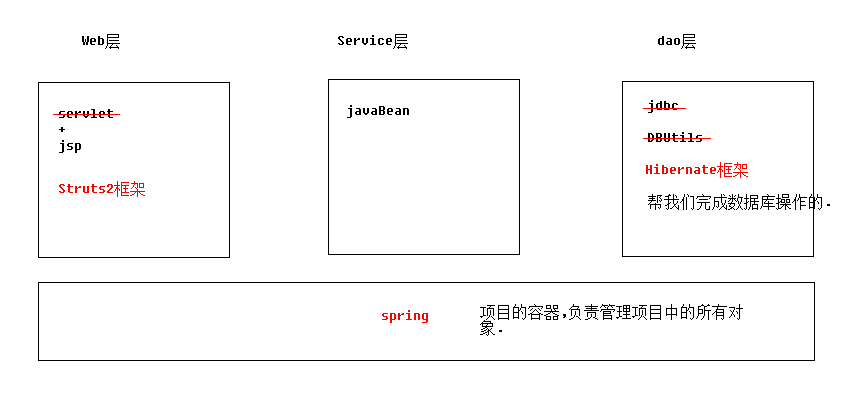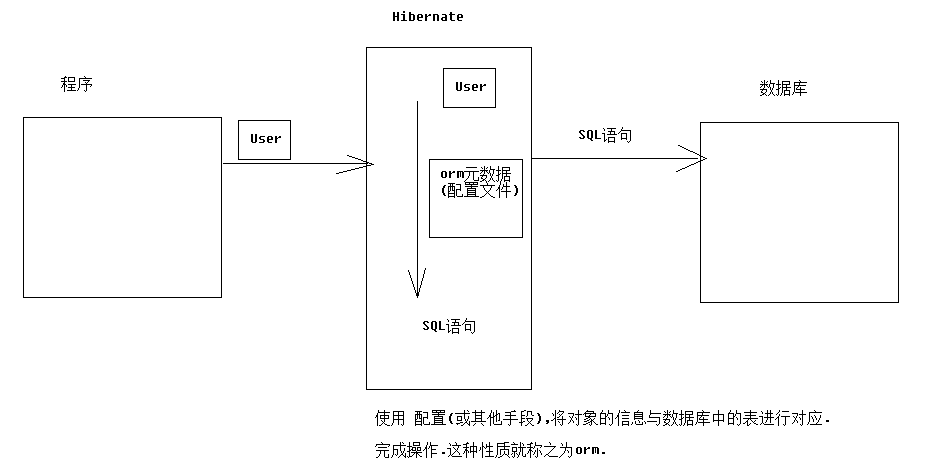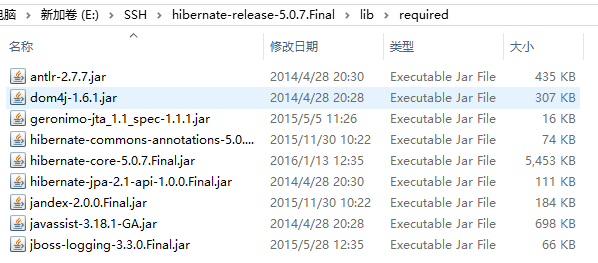一. hibernate是什么
1. 框架是什么
1).框架是用来提高开发效率的
2).封装了好了一些功能.我们需要使用这些功能时,调用即可.不需要再手动实现.
3).所以框架可以理解成是一个半成品的项目.只要懂得如何驾驭这些功能即可.
2. hibernate框架是什么
3. hibernate的好处
1) 操作数据库的时候,可以以面向对象的方式来完成.不需要书写SQL语句
4. hibernate是一款orm框架
orm:object relationg mapping. 对象关系映射
1) orm分4级
hibernate属于4级:完全面向对象操作数据库
mybatis属于2级
dbutils属于1级
二. hibernate框架的搭建
1.导包
1)Jar包
2). 驱动包
2. 创建数据库,准备表,实体
1)数据库表
CREATE TABLE `cst_customer` ( `cust_id` bigint(32) NOT NULL AUTO_INCREMENT COMMENT '客户编号(主键)', `cust_name` varchar(32) NOT NULL COMMENT '客户名称(公司名称)', `cust_user_id` bigint(32) DEFAULT NULL COMMENT '负责人id', `cust_create_id` bigint(32) DEFAULT NULL COMMENT '创建人id', `cust_source` varchar(32) DEFAULT NULL COMMENT '客户信息来源', `cust_industry` varchar(32) DEFAULT NULL COMMENT '客户所属行业', `cust_level` varchar(32) DEFAULT NULL COMMENT '客户级别', `cust_linkman` varchar(64) DEFAULT NULL COMMENT '联系人', `cust_phone` varchar(64) DEFAULT NULL COMMENT '固定电话', `cust_mobile` varchar(16) DEFAULT NULL COMMENT '移动电话', PRIMARY KEY (`cust_id`) )
2)实体
/** * 客户实体类 * @author vanguard * */ public class Customer { private Long cust_id; private String cust_name; private String cust_source; private String cust_industry; private String cust_level; private String cust_linkman; private String cust_phone; private String cust_mobile; public Long getCust_id() { return cust_id; } public void setCust_id(Long cust_id) { this.cust_id = cust_id; } public String getCust_name() { return cust_name; } public void setCust_name(String cust_name) { this.cust_name = cust_name; } public String getCust_source() { return cust_source; } public void setCust_source(String cust_source) { this.cust_source = cust_source; } public String getCust_industry() { return cust_industry; } public void setCust_industry(String cust_industry) { this.cust_industry = cust_industry; } public String getCust_level() { return cust_level; } public void setCust_level(String cust_level) { this.cust_level = cust_level; } public String getCust_linkman() { return cust_linkman; } public void setCust_linkman(String cust_linkman) { this.cust_linkman = cust_linkman; } public String getCust_phone() { return cust_phone; } public void setCust_phone(String cust_phone) { this.cust_phone = cust_phone; } public String getCust_mobile() { return cust_mobile; } public void setCust_mobile(String cust_mobile) { this.cust_mobile = cust_mobile; } @Override public String toString() { return "Customer [cust_id=" + cust_id + ", cust_name=" + cust_name + "]"; } }
3. 书写orm元数据(对象与表的映射配置文件)
1)导入约束
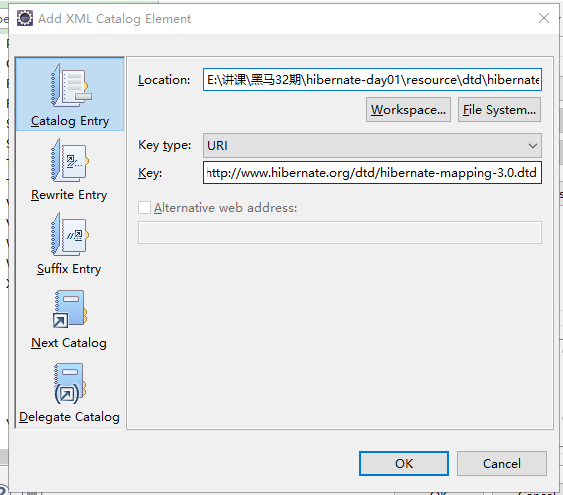
2)
<!DOCTYPE hibernate-mapping PUBLIC "-//Hibernate/Hibernate Mapping DTD 3.0//EN" "http://www.hibernate.org/dtd/hibernate-mapping-3.0.dtd">
3)ORM元数据

4 书写主配置文件
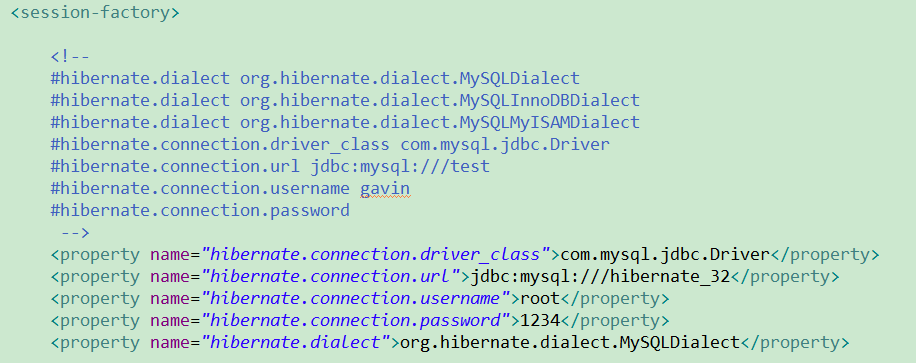
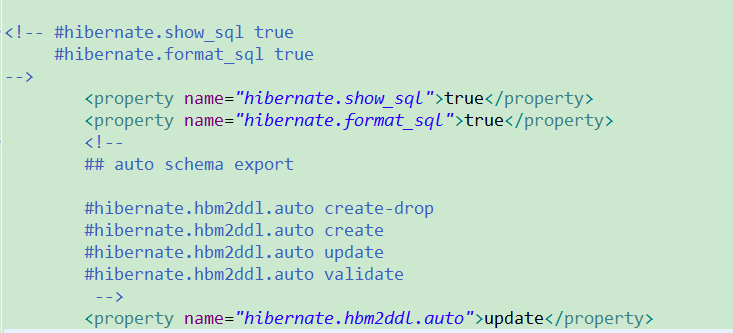

5.书写代码测试
/** * hibernate快速入门 * 使用hibernate操作客户表b * @author vanguard * */ public class Demo { @Test public void fun() { //1. 创建Configuration对象并加载主配置文件 Configuration conf = new Configuration().configure(); //2. 根据配置文件,创建SessionFactory对象 SessionFactory sf = conf.buildSessionFactory(); //3. 获得session对象 Session session = sf.openSession(); //4. 开启事务 Transaction tx = session.beginTransaction(); /********************************/ Customer c = new Customer(); c.setCust_name("google"); //执行保存 session.save(c); /********************************/ // 提交事务 tx.commit(); //释放资源 session.close(); sf.close(); } }
三 配置文件详解
1 orm元数据
1 <?xml version="1.0" encoding="UTF-8"?> 2 <!DOCTYPE hibernate-mapping PUBLIC 3 "-//Hibernate/Hibernate Mapping DTD 3.0//EN" 4 "http://www.hibernate.org/dtd/hibernate-mapping-3.0.dtd"> 5 6 <!-- 配置表与实体对象的关系 --> 7 <!-- package属性:填写一个包名,在元素内部凡是需要完整的类名的属性,直接写简化的类名 --> 8 <hibernate-mapping package="com.java.domain"> 9 10 <!-- 11 class元素:配置实体与表的对应关系 12 name:完整类名 13 table:数据库表名 14 --> 15 <class name="Customer" table="cst_customer"> 16 17 <!-- 18 id元素:配置主键映射的属性 19 name:填写主键对应的属性名 20 column(可选):填写表中的主键列名.默认值:主键会默认使用属性名 21 type(可选):填写列(属性)的类型。hibernate会自动检测实体的属性类型 22 每个类型有三种填法:java类型|hibernate类型|数据库类型 23 not-null(可选):配置该属性(列)是否不能为空。默认值:false 24 length(可选):配置数据库中列的长度。默认值:使用数据库类型的最大长度 25 --> 26 <id name="cust_id" column="cust_id"> 27 <!-- 主键生成策略(7个) 28 identity:主键自增,有数据库维护主键值,录入时不需要指定主键 29 sequence:Oracle中的主键生成策略, 30 increment(了解):主键自增,由hibernate来维护,每次插入前会先查询表中id最大值,+1作为新主键 31 hilo(了解):高低位算法,主键自增,由hibernate维护,开发时不使用 32 native:hile+sequence+identity 自动三选一策略 33 uuid:产生随机字符串作为主键,主键必须是string类型 34 assigned:自然主键生成策略,hibernate不会管理主键值,由开发人员录入 35 --> 36 <generator class="native"></generator> 37 </id> 38 39 <!-- 40 property元素:除id之外的普通属性的映射 41 name:填写属性名 42 column(可选):填写列名 默认值:会默认使用属性名 43 type(可选):填写列(属性)的类型。hibernate会自动检测实体的属性类型 44 每个类型有三种填法:java类型|hibernate类型|数据库类型 45 not-null(可选):配置该属性(列)是否不能为空。默认值:false 46 length(可选):配置数据库中列的长度。默认值:使用数据库类型的最大长度 47 --> 48 <property name="cust_name" column="cust_name"> 49 <!-- <column name="cust_name" sql-type="varchar"></column> --> 50 </property> 51 <property name="cust_source" column="cust_source"></property> 52 <property name="cust_industry" column="cust_industry"></property> 53 <property name="cust_level" column="cust_level"></property> 54 <property name="cust_linkman" column="cust_linkman"></property> 55 <property name="cust_phone" column="cust_phone"></property> 56 <property name="cust_mobile" column="cust_mobile"></property> 57 </class> 58 </hibernate-mapping>
2 hibernate主配置
1) 必选属性配置(5个)
<!-- 必选属性配置(5个) --> <!-- 数据库驱动 --> <property name="hibernate.connection.driver_class">com.mysql.jdbc.Driver</property> <!-- 数据库url --> <property name="hibernate.connection.url">jdbc:mysql:///crm</property> <!-- 数据库连接用户名 --> <property name="hibernate.connection.username">root</property> <!-- 数据库连接密码 --> <property name="hibernate.connection.password">root</property> <!-- 数据库方言: 不同数据库中,sql语法略有区别,指定方言可以让hibernate框架再生成sql语句时,针对数据库的方言生成 sql99标准: DDL:数据定义语言 库表的增删改查 DCL:数据控制语言 事务 权限 DML:数据操纵语言 增删改查 注意:mysql在选择方言时,选择最短的方言 org.hibernate.dialect.MySQLDialect --> <property name="hibernate.dialect">org.hibernate.dialect.MySQLDialect</property>
2) 可选属性配置(3个)
<!-- 可选的配置(3个) --> <!-- #hibernate.show_sql true #hibernate.format_sql true --> <!-- 将hibernate生成的sql语句打印在控制台 --> <property name="hibernate.show_sql">true</property> <!-- 将hibernate生成sql语句格式化(缩进) --> <property name="hibernate.format_sql">true</property> <!-- ## auto schema export 自动导出表结构 自动建表 #hibernate.hbm2ddl.auto create 自动建表,每次运行框架都会创建新的表,以前的表会被覆盖,数据会丢失(开发环境测试使用) #hibernate.hbm2ddl.auto create-drop 自动建表,每次运行框架运行结束都会删除所用表(测试环境中使用) #hibernate.hbm2ddl.auto update(推荐使用) 自动生成表,如果已经存在不会再生成,如果表有变动,自动更新表(不会删除任何数据) #hibernate.hbm2ddl.auto validate 校验:不自动建表,每次启动会校验数据库中的表是否正确,不正确则校验失败,抛出异常 --> <property name="hibernate.hbm2ddl.auto">update</property>
3) 元数据引入配置
<!-- 引入orm数据源 路径填写:src下的路径 --> <mapping resource="com/java/domain/Customer_hbm.xml"/>
四、hibernateAPI详解
1 Configuration
/** * Configuration */ @Test public void fun1() { //1. 创建configuration对象,调用空参构造 Configuration configure = new Configuration(); //2. 读取配置文件 Configuration conf = configure.configure(); //3. 读取指定的orm元数据(扩展),如果主配置中已经引入映射配置文件不需要手动加载 // conf.addResource(resourceName); // conf.addClass(persistentClass); //4. 根据配置文件,创建SessionFactory SessionFactory sessionFactory = conf.buildSessionFactory(); sessionFactory.close(); }
2 SessionFactory
SessionFactory对象
功能:用于创建数据库核心对象session对象的工厂。简单说就是创建session对象。
注意:1. sessionFactory用于保存和使用所有配置信息,消耗内存资源非常大
2. sessionFactory属于线程安全的对象
结论:保证WEB应项目中,只创建一个sessionFactory
/** * SessionFactory对象 * 功能:用于创建数据库核心对象session对象的工厂。简单说就是创建session对象。 * 注意:1. sessionFactory用于保存和使用所有配置信息,消耗内存资源非常大 * 2. sessionFactory属于线程安全的对象 * 结论:保证WEB应项目中,只创建一个sessionFactory * */ @Test public void fun2() { //1. 创建configuration对象,并读取配置文件 Configuration conf = new Configuration().configure(); //2. 根据配置文件,创建SessionFactory SessionFactory sessionFactory = conf.buildSessionFactory(); //3. 打开一个新的session对象 Session session = sessionFactory.openSession(); //获得与线程绑定的esssion对象 Session session2 = sessionFactory.getCurrentSession(); sessionFactory.close(); }
3 Session
Session对象
功能:表示hibernate框架与数据库之前的连接(会话),sesssion类似于
JDBC的connection对象,还可以完成对数据库的增删改查操作,
session是hibernate操作数据库的核心对象
/** * Session对象 * 功能:表示hibernate框架与数据库之前的连接(会话),sesssion类似于 * JDBC的connection对象,还可以完成对数据库的增删改查操作, * session是hibernate操作数据库的核心对象 */ @Test public void fun3() { //1. 创建Configuration对象,并加载配置文件 Configuration conf = new Configuration().configure(); //2. 建立sessionfactory工厂对象 SessionFactory sf = conf.buildSessionFactory(); //3. 打开一个新的session对象 Session session = sf.openSession(); //4. 获得事务 Transaction tx = session.getTransaction(); //5. 开启事务 tx.begin(); }
1) session对数据库进行增加操作
/** * session对数据库进行增加的操作 */ @Test public void fun1() { //1. 创建Configuration对象,并加载配置文件 Configuration conf = new Configuration().configure(); //2. 建立sessionfactory工厂对象 SessionFactory sf = conf.buildSessionFactory(); //3. 打开一个新的session对象 Session session = sf.openSession(); //4. 开启事务并获得操作事务的对象 Transaction tx = session.beginTransaction(); /*********操作数据库********************/ Customer c = new Customer(); c.setCust_name("百度"); session.save(c); /**************************************/ //提交事务 tx.commit(); //释放资源 session.close(); sf.close(); }
2)session对数据进行查询操作
/** * 对数据库进行查询操作 */ @Test public void fun2() { //1. 创建configuraion对象并加载配置文件 Configuration conf = new Configuration().configure(); //2. 创建sessionfactory工厂 SessionFactory sf = conf.buildSessionFactory(); //3. 打开一个新的session对象 Session session = sf.openSession(); //4. 开启事务并获得操作事务的对象 Transaction tx = session.beginTransaction(); //5. 对数据库进行删除操作 //获得需要修改的对象 Customer customer = session.get(Customer.class, 2l); System.out.println(customer); //6. 提交事务 tx.commit(); //7. 释放资源 session.close(); sf.close(); }
3)session对数据库进行删除操作
/** * session对数据库进行删除操作 */ @Test public void fun3() { //1. 创建configuraion对象并加载配置文件 Configuration conf = new Configuration().configure(); //2. 创建sessionfactory工厂 SessionFactory sf = conf.buildSessionFactory(); //3. 打开一个新的session对象 Session session = sf.openSession(); //4. 开启事务并获得操作事务的对象 Transaction tx = session.beginTransaction(); //5. 对数据库进行删除操作 //获得需要删除的对象 Customer customer = session.get(Customer.class, 1l); //执行删除操作 session.delete(customer); //6. 提交事务 tx.commit(); //7. 释放资源 session.close(); sf.close(); }
4)session对数据库进行修改操作
/** * 对数据库进行修改操作 */ @Test public void fun4() { //1. 创建configuraion对象并加载配置文件 Configuration conf = new Configuration().configure(); //2. 创建sessionfactory工厂 SessionFactory sf = conf.buildSessionFactory(); //3. 打开一个新的session对象 Session session = sf.openSession(); //4. 开启事务并获得操作事务的对象 Transaction tx = session.beginTransaction(); //5. 对数据库进行删除操作 //获得需要修改的对象 Customer customer = session.get(Customer.class, 2l); customer.setCust_name("腾讯"); //执行修改操作 session.update(customer); //6. 提交事务 tx.commit(); //7. 释放资源 session.close(); sf.close(); }
4. Tracsaction
hibernate内部封装了事务的操作,只需要调用方法即可
1)打开事务
方式一:
//1. 获得事务 Transaction tx = session.getTransaction(); //2. 开启事务 tx.begin();
方式二(推荐):
// 开启事务并获得操作事务的对象 Transaction tx = session.beginTransaction();
2)提交事务
tx.commit();
3)回滚事务
tx.rollback();
